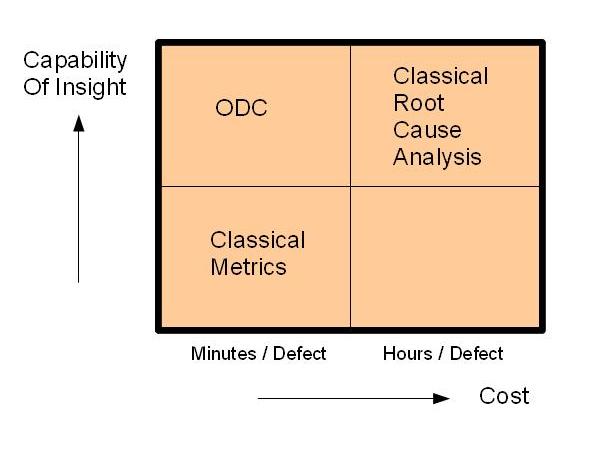How does ODC (Orthogonal Defect Classification) based root cause analysis (RCA) compare with the classical root cause analysis in terms of speed of RCA? The figure below with the four quadrants that divide cost and capability illustrates the basis differences.  The X axis captures cost in terms of time spent per defect for analysis. In the case of classical root cause analysis, where a small team of engineers - say two to four spend discussing a defects (like a quality circle) the time invested per defect will typically range from 1-5 hours. And, one has to spend a reasonable amount of time in this process, since one is looking for systemic issues, and a small deep dive is conducted on why this defects occurred. Infact, there are a series of whys that need to be studied. That is both the strength and weakness of the process. The open ended why's can sometimes uncover issues that otherwise escape the casual observer.
The X axis captures cost in terms of time spent per defect for analysis. In the case of classical root cause analysis, where a small team of engineers - say two to four spend discussing a defects (like a quality circle) the time invested per defect will typically range from 1-5 hours. And, one has to spend a reasonable amount of time in this process, since one is looking for systemic issues, and a small deep dive is conducted on why this defects occurred. Infact, there are a series of whys that need to be studied. That is both the strength and weakness of the process. The open ended why's can sometimes uncover issues that otherwise escape the casual observer.
However, the ODC based RCA is done differently. We first categorize the defects using ODC. This categorization process is not a root cause analysis, instead is a rapid categorization using a specified "C-flow" through the defect, and is performed in three to four minutes. After a set of defects, say thirty or a hundred, the analysis is conducted using statistical tools and specific ODC methods of data exploration. This is performed by one person who is an ODC Analysis, and can take a few hours. Thus the total cost of analysis is reduced on average from hours per defect to minutes per defect.
Another discussion on this topic can be found in the article ODC - a 10x on Root Cause Analysis